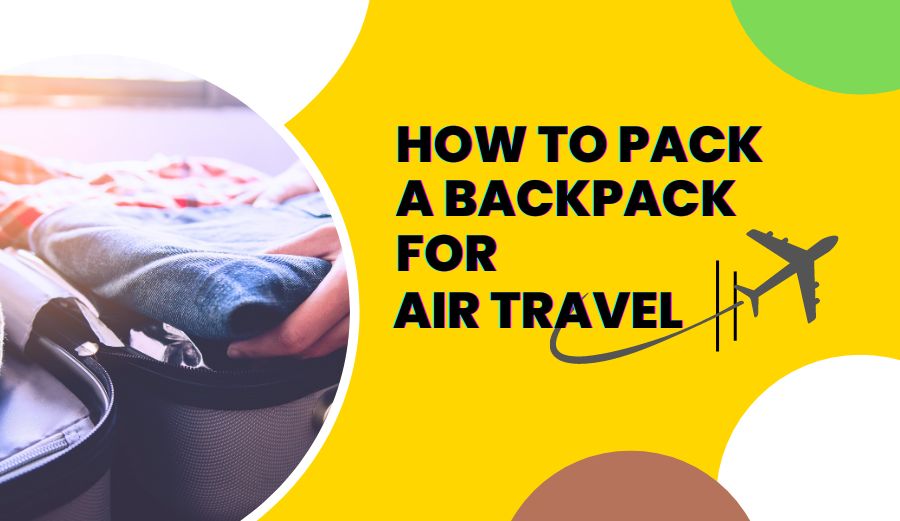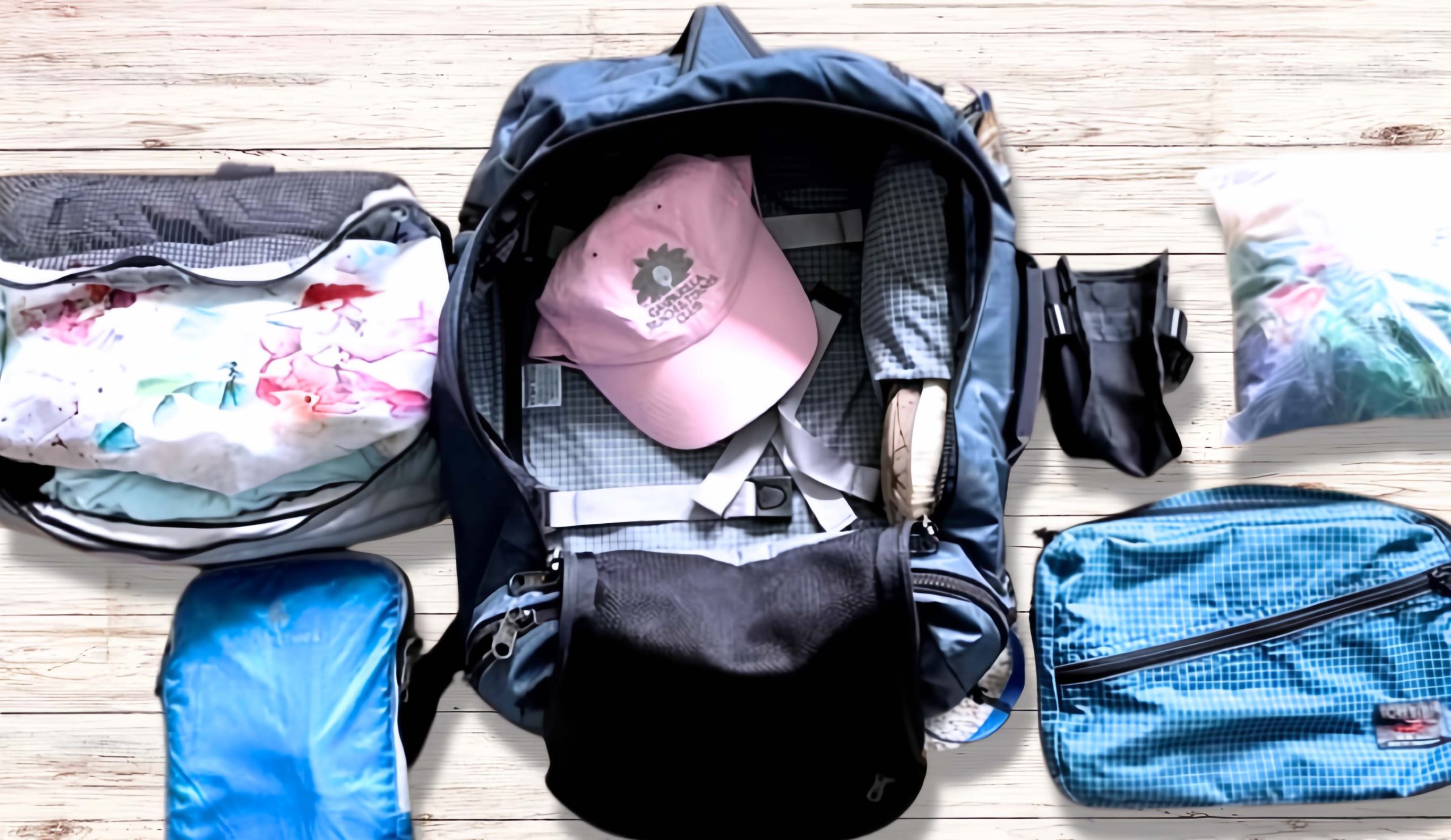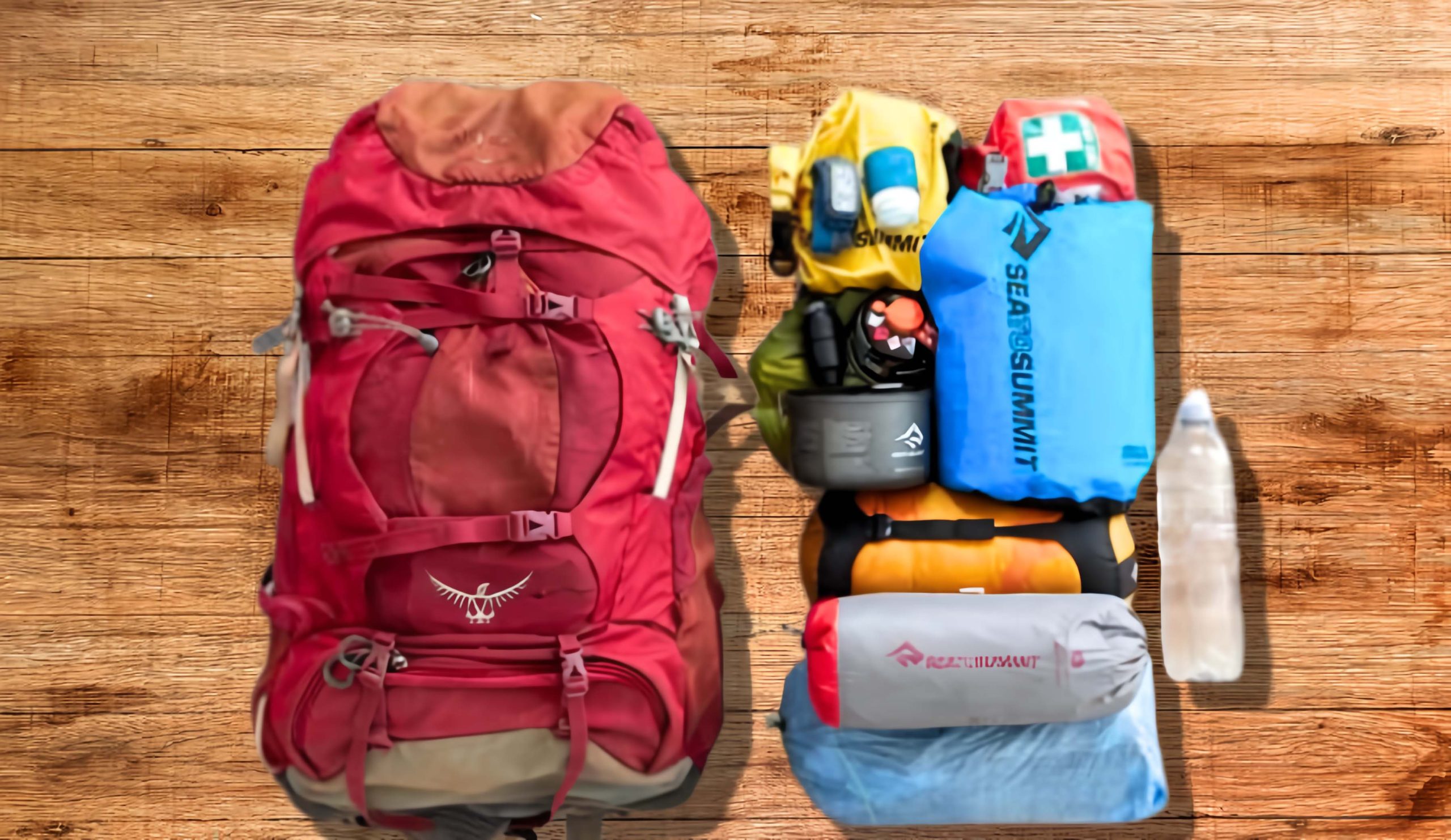Jet-Set Ready: Learn How to Pack A Backpack for Air Travel in 2023
Efficient packing is the key to stress-free air travel. Learn How to Pack A Backpack for Air Travel to save money, prevent mishaps, and make your journey comfortable and enjoyable.

Are you tired of wrestling with bulky suitcases at the airport? How do I maximize space while minimizing stress? When it comes to hassle-free air travel, knowing How to Pack A Backpack for Air Travel is your secret weapon. Picture this: no more lost luggage, no extra fees, and the freedom to explore without being weighed down.
In this article, we’ll unlock the art of backpack packing, offering expert insights and intelligent packing tips to revolutionize your journey. So, are you ready to embark on a packing adventure and transform your travel experience?
Table of Contents
TogglePlanning for Success
Before you dive into packing, it’s crucial to lay a strong foundation through meticulous planning. Preparing in advance can make a difference in ensuring a smooth and enjoyable air travel experience. Here’s why knowing How to Pack A Backpack for Air Travel begins with strategic planning:
Tailoring Your Wardrobe to the Terrain: Your destination sets the stage for your packing strategy. Ask yourself: Will you explore urban landscapes, basking on a beach, or trekking through rugged terrain? The activities you have planned for your trip should guide your clothing choices. For Scandinavian adventures, think warm layers; for tropical escapes, opt for breathable fabrics.
Lighter Is Better: Traveling light is a golden rule. Overpacking can lead to unnecessary strain on your body and airline baggage fees. Remember, it’s often better to have a few versatile pieces that you can mix and match than to cram your bag with unnecessary options. Two pairs of jeans can go a long way.
Footwear Matters: Your choice of footwear should align with your itinerary. Flip-flops may be ideal for a beach holiday but a hindrance on a hiking trip. Consider comfort and practicality while deciding on the right shoes. Sneakers and sandals can be versatile, while heavy hiking boots may only be necessary for specific adventures.
Tech and Gadgets: Think twice before packing your entire tech arsenal. Consider whether you truly need a laptop, tablet, or smartphone. Can your smartphone serve as your primary camera? Streamline your tech gadgets to lighten your load and avoid potential damage.
Airlines’ Rules and Weight Limits: Airlines have rules and weight restrictions for carry-on and checked baggage. Adherence to these guidelines can result in hefty fees. Research and stay informed about your chosen airline’s specific baggage policies.
By planning meticulously, you’ll be equipped with the knowledge to pack your backpack intelligently for air travel, ensuring you’re ready to embark on your journey confidently and efficiently.
Lay It All Out

Now that you understand the importance of planning, it’s time to dive into the practical side of packing. Here’s how to tackle the next step in mastering How to Pack A Backpack for Air Travel:
The Unveiling: Begin by clearing a space, whether it’s your bed, the floor, or a large table. This will be your packing zone. Next, gather all the items you plan to take on your journey. Lay them out in plain view. It’s like creating a visual inventory of everything you intend to carry.
The Art of Piles: The secret to organized packing lies in categorization. Start by dividing your items into distinct piles:
- Clothes: Arrange your clothing items neatly in one pile. This should include everything from tops and bottoms to underwear and outerwear.
- Footwear: Set aside your shoes and socks in a separate pile. Ensure they are clean and debris-free to keep your other items pristine.
- Essentials: This pile should include crucial travel documents, passports, travel insurance, a first aid kit, and any items essential to your trip’s success.
- Luxury: Consider this your “extras” pile. It may include additional gadgets, toiletries, or non-essential personal items.
- Others: This category is for anything that doesn’t fit neatly into the previous piles but is still essential for your trip. Think chargers, adaptors, and travel-sized laundry detergent.
The Power of Checklists: Packing isn’t just about what you put in your backpack; it’s also about what you leave behind. To keep track of your belongings and stay organized, create a checklist. List each item in its respective pile. This checklist will serve as your packing roadmap, helping you ensure everything is noticed.
Creating piles and using checklists streamlines your packing process and makes it easier to spot potential gaps or unnecessary items. With this structured approach, you’ll be well on your way to packing your backpack with confidence and precision.
Be Ruthless

Adopting a ruthless approach to your belongings is the key to success when packing for air travel. Here’s why being selective and discerning is vital in mastering How to Pack A Backpack for Air Travel:
- Streamlining for Comfort: Carrying a hefty backpack can lead to discomfort, fatigue, and even injury. Ruthlessly assess each item’s necessity to avoid overburdening yourself. Remember, every ounce counts when you’re on the move.
- Maximizing Exploration: Travel is about experiences, not possessions. By minimizing your load, you’ll be more agile and flexible, allowing you to fully engage with your surroundings and immerse yourself in the culture of your destination.
- Avoiding Excess Fees: Airlines often charge hefty fees for exceeding weight limits. Being ruthless with your packing helps you stay within these limits, saving you money that can be better spent on enjoying your trip.
Here are strategies to reduce backpack weight and make informed choices:
- Duplicate Check: Identify items that serve the same purpose. Do you need a laptop and a tablet, or can one suffice?
- Seasonal Selection: Tailor your clothing choices to the weather and climate of your destination. Leave behind bulky winter wear for warm-weather getaways.
- Toiletry Takedown: Minimize toiletries by selecting travel-sized options or purchasing items upon arrival. Remember, many hotels provide basic toiletries.
- Laundry Planning: Plan to wash and re-wear clothing during your trip. A small packet of laundry detergent can be a game-changer.
- Digital Library: Instead of packing a stack of books, consider e-readers or audiobooks to save space and weight.
- Non-Essential Elimination: Identify items that can be easily acquired at your destination. This could include toiletries, snacks, or certain clothing items. Embrace the local culture and shop locally when needed.
Remember, packing light eases your journey and opens up opportunities for spontaneity and exploration. By being ruthless in your packing decisions, you’ll embark on your air travel adventure unburdened and ready for new experiences.
Choosing the Right Backpack

Selecting the perfect backpack for air travel is pivotal in mastering How to Pack A Backpack for Air Travel. Here’s why getting the right backpack matters and how to make the best choice:
Size Matters: The size of your backpack should align with your travel style. If you’re aiming for carry-on convenience, opt for a smaller bag that fits within airline regulations. Larger bags are suitable for longer trips with more gear.
Comfort is Key: Comfort is non-negotiable, especially if you’ll be wearing your backpack for extended periods. Look for padded shoulder straps and an adjustable sternum strap to distribute weight evenly. A padded hip belt is essential for support, especially with heavier loads.
Quality Counts: Invest in a backpack with sturdy construction and durable materials. Pay attention to reinforced seams and quality zippers to ensure your pack withstands the rigors of air travel.
Accessibility: Quick access to essentials like your passport, boarding pass, and small electronics is a game-changer. Choose a backpack with strategically placed pockets or compartments for easy retrieval.
Luggage or Backpack Hybrid: Some backpacks offer the versatility of bag and rolling luggage, with wheels and a retractable handle. This hybrid design can be convenient if you’ll frequently move through airports.
Lockable Zippers: Security is paramount. Opt for a backpack with lockable zippers to keep your belongings safe during transit.
Water Resistance: You never know when you might encounter rain. Look for a backpack with a water-resistant coating or a rain cover to protect your gear.
Weight Distribution: Backpacks with an internal frame provide better weight distribution, enhancing comfort and balance during your travels.
Aircraft-Friendly Features: Ensure your chosen backpack meets airline size regulations for carry-on luggage. Bags with stowable straps and a removable daypack or detachable components offer added convenience.
Test It Out: Whenever possible, try on the backpack before purchasing. Load it with some weight to gauge its comfort and fit.
Remember that the right backpack is like a trusted travel companion, making your journey smoother and more enjoyable. Considering size, comfort, quality, and practical features, you’ll be well-prepared to choose the perfect backpack for your air travel adventures.
Backpack Packing Techniques

Packing a backpack for air travel is a unique art, distinct from packing other luggage types. Here’s how to master this art and make the most of your backpack’s space:
Backpack vs. Other Luggage: Packs have different shapes and dimensions, making packing techniques crucial, unlike traditional suitcases or duffel bags. Here’s why:
- Shape Matters: Backpacks are tall and narrow, requiring a different approach to maximize space.
- Accessibility: Unlike a suitcase that opens like a clamshell, backpacks typically have a top-loading design. This means you’ll need to strategically organize your items for easy access.
Roll Your Clothes: Rolling your clothes is a space-saving technique favored by backpackers. It minimizes wrinkles and creates compact bundles that can be neatly stacked inside your backpack. Use the army roll technique for items like T-shirts and jeans to keep them tightly wound and compact.
Compression Bags: Compression bags are a game-changer when saving space. They remove excess air from your clothes, making them more compact. Pack your clothes into these bags and use a vacuum or manual valve to clear the air. This not only saves space but also keeps your clothes organized and protected.
Packing Cubes: While packing cubes are more commonly associated with suitcases, they can be used in backpacks, too, especially if you find the right size and shape. These cubes help you stay organized by separating items into different compartments. Consider using them for smaller items or to keep your clothes neatly divided.
Combination Strategy: To truly master backpack packing, combine these techniques. Roll your clothes, then pack them into compression bags. Place these compressed bundles in your backpack, using packing cubes to separate different types of clothing or accessories. This combination approach ensures maximum space utilization while keeping your items organized and easily accessible.
Remember, the key to efficient backpack packing is optimizing every inch of available space. By adapting these techniques to suit your needs, you’ll be able to pack smartly and make the most of your backpack’s unique design.
Order of Packing

Packing your backpack efficiently is more than just fitting items inside; it’s about ensuring comfort, accessibility, and balance throughout your journey. Here’s a breakdown of the ideal order of packing and why it matters:
Lightweight and Non-Essentials Go First: Start placing your light and less essential items at the bottom of your backpack. This includes your sleeping bag or gear you won’t need during the flight. Positioning these items at the base creates a stable foundation and prevents your backpack from toppling over.
Clothes in Compression Bags: If you’ve used compression bags to pack your clothes, these should come next. Place them above your lightweight items. Compression bags save space and help maintain the weight distribution within the backpack.
Gadgets Go in the Middle: The middle section of your backpack is the ideal spot for your devices, including laptops, cameras, or any other heavy items. This placement protects your gadgets, minimizing the risk of damage during transit. Use protective sleeves or cases to safeguard your electronics from bumps and jostles.
Things You Need During the Flight at the Top: The top section of your backpack should be reserved for items you’ll require during the flight. This includes your jacket, passport, tablet or entertainment device, eye mask, earplugs, and essential travel documents. Keeping these essentials within easy reach means you won’t have to dig through your entire backpack on the plane.
Keep it Balanced: Evenly distribute the weight of your packed items throughout your backpack. Balancing the load prevents strain on your shoulders and ensures better stability while wearing it. Aim to keep the heaviest things centered and close to your back to maintain your center of gravity.
Consider Side Pockets: Utilize side pockets or compartments for items like water bottles or snacks that you may need quick access to during your journey.
Remember that your backpack should be organized in a way that makes sense to you, ensuring you can quickly locate items when needed. Packaging strategically and considering the order will enhance your overall travel experience and minimize the hassle of searching for essentials during your flight.
Additional Tips for Air Travel

As you prepare for air travel with your backpack, here are some additional tips to make your journey more comfortable and stress-free:
Wear Bulky Items: To reduce the weight of your backpack, consider wearing your bulkier clothes and footwear on the flight. This might include your hiking boots, a sweater, or a jacket. Wearing these items instead of packing them will save space and weight in your backpack. Plus, if needed, you can easily change into more comfortable clothing during the flight.
Carry a Secondary Bag: Bring a small secondary bag or daypack that can fit under your seat along your main backpack. This secondary bag can hold essentials like snacks, headphones, an extra layer of clothing, and anything you’d like to access quickly during the flight. It’s also convenient for shorter outings during your trip when you want to avoid carrying your giant backpack.
Focus on Enjoyment: While efficient packing is crucial, keep it from becoming the focus of your trip. The ultimate goal of your journey is to explore and experience new places, cultures, and adventures. Once you’ve mastered packing a backpack for air travel, relax and enjoy your trips without worrying about a bulky bag. Remember, the less you stress about your luggage, the more you can savor every moment of your adventure.
By following these additional tips and mastering the art of packing your backpack, you’ll not only travel with ease but also have the freedom to fully immerse yourself in the wonders of your destination. Safe travels!
TSA and Airline Restrictions

Before you embark on your air travel adventure, it’s crucial to be aware of TSA and airline restrictions to ensure a smooth journey:
Sharp Objects: TSA regulations dictate that knives, blade razors, hatchets, and ice axes must be placed in checked baggage. Metal scissors with pointed tips and blades over four inches are prohibited in carry-on or checked bags. Still, shorter or rounded-point scissors are allowed in checked baggage.
Fire, Fuel, and Aerosols: Canister fuel, white gas, denatured alcohol, strike-anywhere matches, and pepper sprays larger than 4 oz are prohibited in carry-on or checked baggage and should be purchased at your destination. Small cigarette lighters, regular matches, and small containers of aerosol toiletries are generally permitted in carry-on luggage.
Batteries: Battery packs must be carried on and not checked. Be aware that if battery packs are discovered during a TSA inspection, they may be removed, and your bag might be delayed.
Firearms: Firearms and ammunition are prohibited in carry-on baggage but may be checked. Specific rules regarding storage and locks vary between airlines, so check with your airline before traveling.
Liquids, Creams, and Gels: Liquids, creams, or pastes in quantities under 3.4 ounces can be carried on if they fit in a single clear quart-size plastic bag. TSA also limits the amount of most individual liquids, pastes, gel toiletries, and food or drink containers to 3.4 ounces in your carry-on. Fluids can be carried in checked baggage but may have additional restrictions.
Luggage Weight Limits: Most significant airlines set a weight limit of 50 pounds (23 kg) for each checked bag for economy passengers. Carry-on bags are generally restricted to one bag no larger than 9 inches x 14 inches x 22 inches. Smaller carriers and some domestic flights may have lower weight limits. Check your specific airline’s baggage weight limits to avoid surprises at the check-in desk.
Special Gear: Items like trekking poles and camping gear require extra attention. Trekking poles should be placed in checked baggage, and it’s wise to check your airline’s policy on camping gear like stoves, fuel canisters, and tents. Some equipment must be cleaned thoroughly before packing to meet customs and TSA regulations.
Understanding and adhering to these TSA and airline restrictions can prevent delays and ensure a hassle-free journey. Always double-check the latest regulations before your trip to stay up-to-date with any changes.
Packing Food for Air Travel

When it comes to packing food for your air travel adventure, here are some tips and considerations to keep in mind:
Shop at Your Destination: One of the joys of traveling is exploring your destination’s local cuisine and food markets. Instead of lugging a ton of food from home, consider shopping for trail food and snacks after you arrive. This allows you to discover unique and tasty items outside your home country. Plus, it’s an excellent way to immerse yourself in the local culture.
Dietary Requirements: If you have specific dietary requirements or preferences, research your destination beforehand to ensure you’ll find suitable food options. Many parts of the world now offer gluten-free, vegan, and other specialized diets. However, planning and researching in advance is wise, especially if you have severe allergies or specific dietary needs.
Customs and Biosecurity Regulations: Some countries have strict regulations regarding the food items you can bring. Commonly prohibited items include raw seeds, fresh fruits, vegetables, dairy, and certain meats. Cooked and commercially packaged freeze-dried or dehydrated foods are typically allowed if they come in their original store packaging. Be sure to check your destination’s customs and biosecurity regulations well in advance to avoid any issues at the airport.
Label Your Food: If you bring food from home, make sure all items are clearly labeled. Items without proper packaging or nutrition labels may be confiscated at customs upon arrival. Declining any food items when you go through customs is essential to avoid potential problems.
Food can be an excellent way to connect with the local culture during your travels. So, while planning for your dietary needs is wise, embrace the opportunity to savor new flavors and culinary experiences at your destination.
Recap
As you prepare for your next air travel adventure, remember that efficient backpack packing can make a difference in your journey. Here’s a quick recap of the key takeaways:
- Planning is Paramount: Your destination, itinerary, and airline restrictions should dictate what you pack. Think strategically about your clothing, footwear, and accessories based on your activities.
- Organize and Simplify: Lay out everything you plan to take, create piles (clothes, footwear, essentials, luxury, others), and make a checklist for better organization.
- Be Ruthless: Eliminate non-essential items and reduce backpack weight. Skip packing items that are readily available for purchase at your destination.
- Choose the Right Backpack: Select a backpack that fits airline size restrictions, prioritizes comfort, and boasts quality features like excellent shoulder straps and padded hip belts.
- Master Packing Techniques: Understand the differences between packing a backpack and other luggage. Learn techniques like rolling clothes, using compression bags, and packing cubes for efficient use of space.
- Order of Packing Matters: Distribute weight evenly, ensuring essentials are easily accessible during the flight.
- Additional Tips for Air Travel: Wear bulky items on the flight to reduce backpack weight, carry a small secondary bag, and focus on enjoying the journey.
- TSA and Airline Restrictions: Comply with TSA regulations, check luggage weight limits, and carefully handle specific gear like trekking poles.
- Packing Food for Air Travel: Consider shopping for trail food at your destination, plan for dietary requirements, and understand customs and biosecurity regulations.
Armed with these insights and tips, you’re well-prepared to embark on your adventure. Travel is about experiencing new cultures, sights, and flavors. Embrace the unknown, savor the moments, and relish the joy of exploration. Bon voyage!
